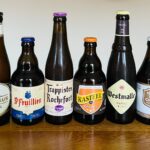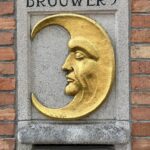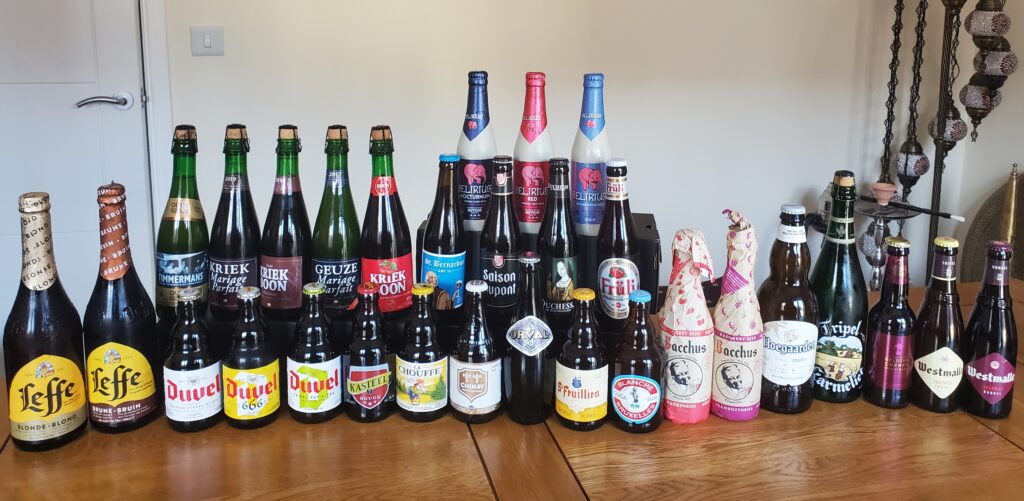
When you think of the best beer-producing countries in the world, Belgium makes it onto most lists. They are known worldwide for the quality of their beers.
Back in 2023, we decided we hadn’t tried nearly enough Belgian beers and we wanted to rectify that. We were able to find a pretty good selection in various supermarkets and craft beer shops around Leeds and we battled them over 11 weeks.
It was then that we bought the newbrewthursday domain name – we wanted somewhere to share our thoughts. We wrote up the notes from each of our weekly battles, but it was another year before the website actually came to life and we can now share those notes.
The 2023 11-week battle
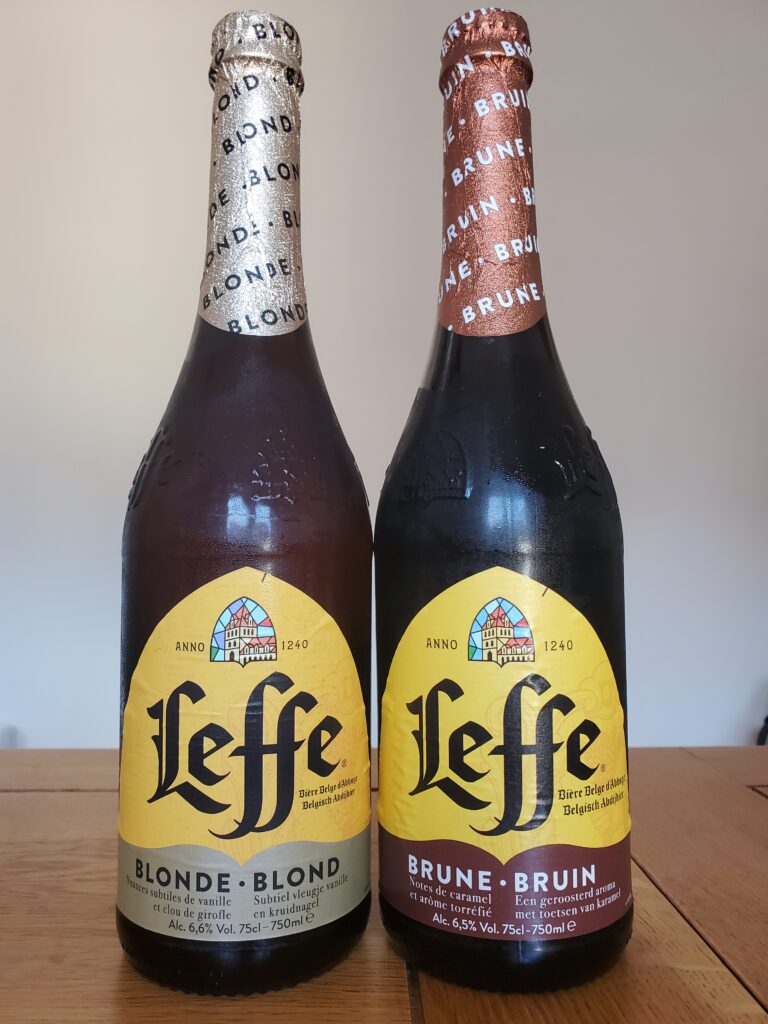
Week 1: Leffe Blonde Vs Leffe Brune
We were hoping not to love these beers, given they are brewed by AB Inbev. It’s not that we aren’t fans of the big breweries, we just prefer it when the independents shine. But, alas, both beers were very good.
Leffe Blonde had the banana-like flavours you find in German wheat beers. It was light and easy to drink, but at 6.6%, you probably wouldn’t want a session on it.
Leffe Brune (6.5%) was more complex in flavour. It still had those banana and spice notes, but there was a deep roastiness and slight sweetness.
We tried them both individually to appreciate the different flavours. Then we sampled them back-to-back with no cleanse in between.
Taking a mouthful of the brown, followed by a mouthful of the blonde, meant the subtlety of flavour in the blonde got lost. But going the other way – blonde to brown – the brown flavours were intensified.
Of course, you wouldn’t sit in a bar with two beers on the go, but if you were staying for a couple, we’d recommend starting with the blonde, before moving on to the brown.
All in all, two very good beers. A good gateway beer if you’re new to Belgian styles and aren’t used to the flavours Belgian yeasts impart.
Lisa’s thoughts: I preferred the brune, but I’d probably stick to just one bottle, whereas I could have a couple of the blondes given their lighter flavour.
Alex’s thoughts: Despite my reservations with these being AB Inbev beers, I enjoyed them both. I thought the Belgian yeast really shone through in the blonde, with lovely banana and clove flavour. The brune was slightly more complex, with lots of dark flavours coming from the malts, though I did start to find it a little too sweet towards the end.
Beer of the night: Tie
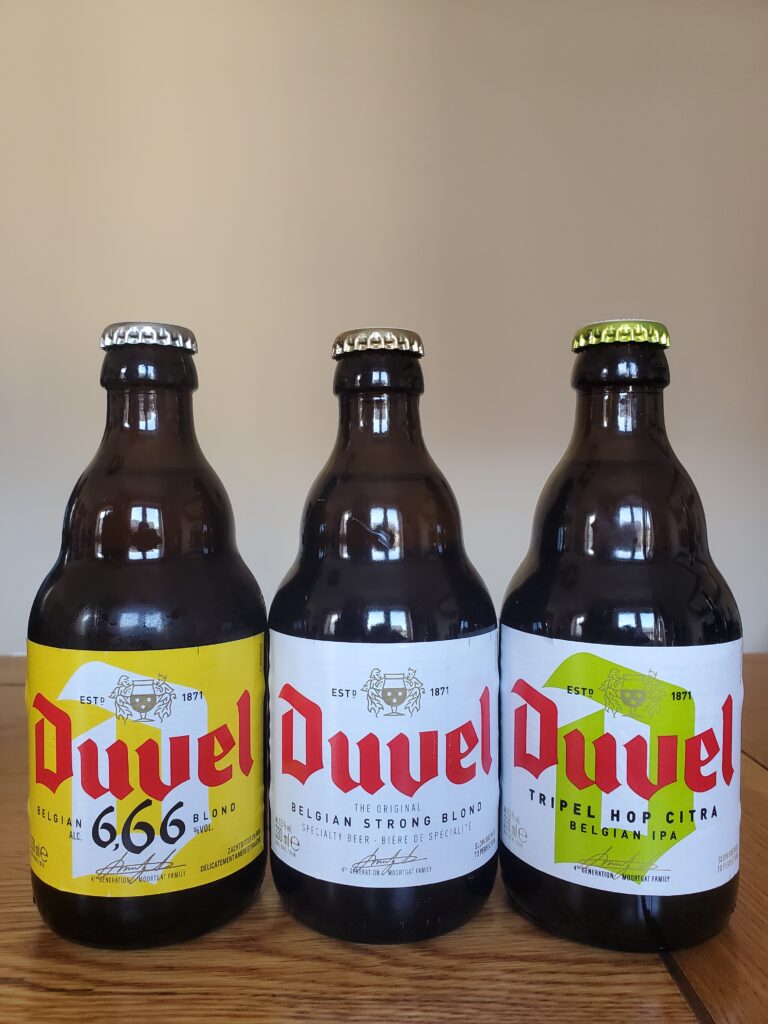
Week 2: Duvel Vs Duvel Tripel Vs Duvel 666
After being so pleasantly surprised by the Leffe, we were really looking forward to this week’s selection. The Duvel original and the Duvel Tripel both feature in 1001 beers you must try before you die, so we had high hopes.
We started on the 666 as it was the lowest ABV (6.66%) and was the only one not to feature in the book. It was a strong start. It had the crispness and lightness of a lager but the distinctive banana and spice flavour of those Belgian yeasts.
It wasn’t quite as good as the Leffe beers from the week before, but it was a good beer.
Next up, the Duvel original. An 8.5% blonde Belgian Ale that’s been around since the 1800s.
Unfortunately, we were both disappointed. Perhaps we’d set out expectations too high, but we just didn’t love it. The upfront flavour was ok, but the aftertaste had a pepperiness about it and a lingering bitterness.
We thought we’d maybe got a bad batch, so we wanted to try it again in our Belgian beer battle to ensure it got a fair shot.
Finally, the Duvel Tripel. Again, this was a little disappointing. The pepperiness just didn’t do it for us, and the alcohol flavour was strong (not surprising at 9.5%). As it warmed up a little, it did get nicer, and some of the other flavours came through a bit more.
Lisa’s thoughts: I liked the 666 with the lightness and crispness coupled with banana flavours you get from the yeasts. But I found the original Duvel and the tripel to be a little bit disappointing. The flavours got lost under the bitterness and strength of the alcohol. And the pepperiness wasn’t particularly to my liking.
Alex’s thoughts: Being someone who doesn’t particularly enjoy strong bitterness in beers, I didn’t love the Duvel range. I really liked the aroma of all of those tasty Belgian yeast but the actual flavours from the majority of them were just too bitter and peppery. As the flavours matured and the bears warmed up slightly from our fridge temperature, I did find them to be more enjoyable, but overall the original and the tripel were just a bit too strong in bitterness and pepperiness for me. My favourite of the selection was the 666, which, for me, was more in line with what I expected from a strong Belgium blonde ale.
Beer of the night: Duvel 666
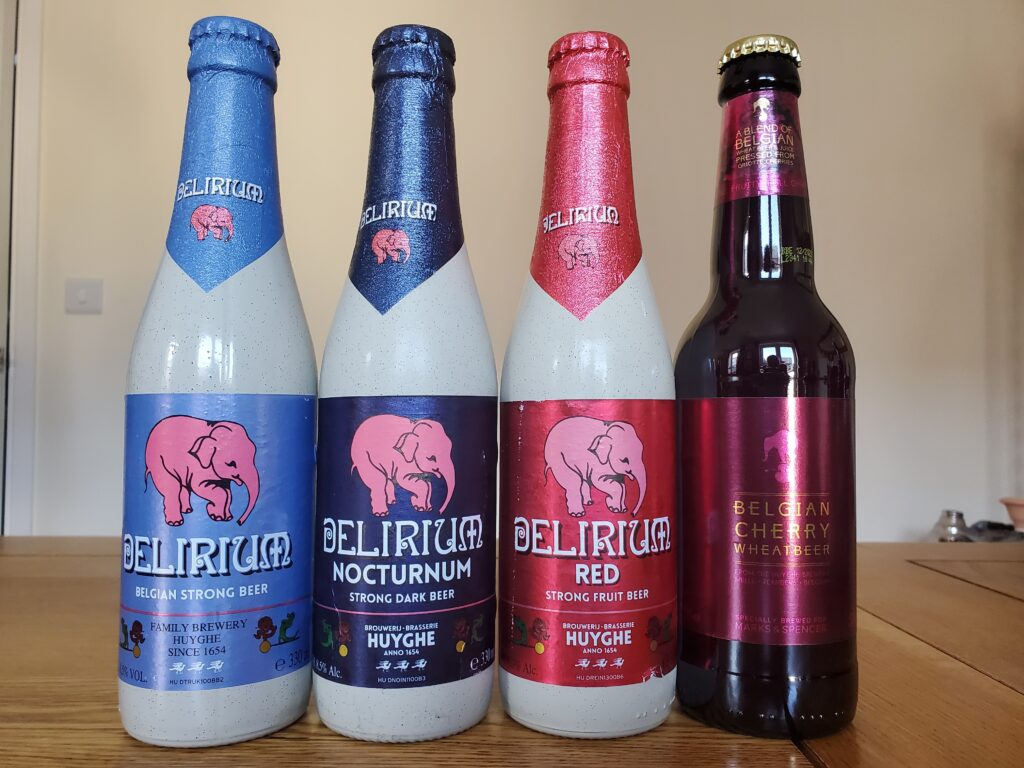
Week 3: 3 x Delirium (and an M&S special)
This week’s selection came from the Huyghe brewery, best known for their Delirium range.
We had three Delirium beers – Tremens (an 8.5% blonde ale), Nocturnum (an 8.5% dark ale) and Red (an 8% cherry beer). We also had the Huyghe Belgian cherry wheat beer (3.5%) that was brewed especially for M&S.
First up was the blonde, and after the disappointment of the Duvel, we were apprehensive. But we needn’t have been at all. The Tremens restored our faith in Belgian blondes. It had a smooth mouthfeel, a delicious flavour, and the alcohol wasn’t overpowering.
Next up, the dark ale – another fantastic beer. It was sweet without being too sweet, and the malts gave it an almost chocolatey flavour. As it warmed up a bit, there were notes of treacle. And it was super smooth. If it wasn’t so strong, we’d have drank it all night.
Finally, we compared the strong cherry beer (8%) with the M&S cherry beer (3.5%). The M&S special was very sweet but with a sour kick. It would make a great spacer being lower in alcohol, but the sweetness could get too much if you stayed on it all evening.
The Delirium Red had a beautiful deep red colour and was far more complex in flavour (as you’d expect). You could really taste the cherries, but the sweetness wasn’t overpowering.
Lisa’s thoughts: A great selection this week with some excellent beers. If they weren’t so strong, I could happily drink any of the Delirium beers all night. The M&S special made a nice spacer, but it was a bit too sweet for my liking – I probably wouldn’t want more than one.
Alex’s thoughts: The Huyghe beers definitely lived up to the expectation of what makes great Belgian Beer. Enjoyed them all.
Beer of the night: Tie between Delirium Tremens and Delirium Nocturnum
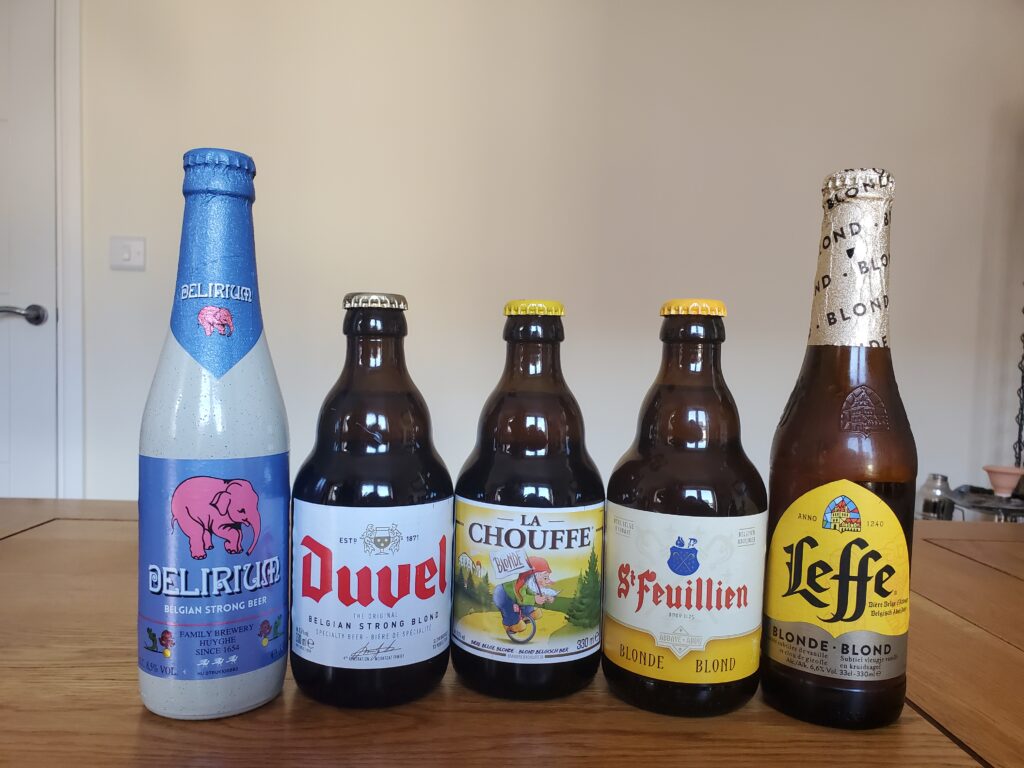
Week 4: Battle of the blondes
We’ve already tried three quality Belgian blondes, but this week we revisited them and added two more into the mix.
First up, we tried the two new additions – St Feuiliien (7.5%) and La Chouffe (8%). Then brought in the Delirium (8.5%), the Leffe (6.6%) and the Duvel (8.5%).
St Feuillien and La Chouffe were both strong contenders – in fact, they were our top two out of the five. St Feuillien was lighter in colour and sweeter in flavour, while La Chouffe was darker in colour with more complexity of flavour. Both came out strong, and neither of us could choose a favourite between the two.
The Delirium retained its place above Duvel and Leffe, but wasn’t quite as good as the St Feuillien or La Chouffe. While we loved Leffe in isolation, it didn’t hold up as well when compared to other blondes – understandable given the lower alcohol content. A good entry into blondes but nowhere near as complex in flavour.
The Duvel faired better this time around – perhaps we did get a bad bottle last time. We both upgraded our initial score but agreed it was our least favourite of the five.
Lisa’s thoughts: Belgian blonde isn’t my favourite style of beer, but all five of these are good quality. The Leffe is a great entry to blondes, and I’d lean toward St Feuillien if you like a bit of sweetness. La Chouffe and Delirium have good depth of flavour, while the Duvel would be a good choice if you like a strong alcohol flavour in your blondes.
Alex’s thoughts: Overall, I am a big fan of Belgian blondes – I particularly love the banana aromas and sweet malt flavours. Doing this tasting has shown me that not all Belgian blondes were created equal. My winners were the ones with the sweeter flavours – St Feuillien and La Chouffe.
Beer of the night: Tie between St Feuillien and La Chouffe
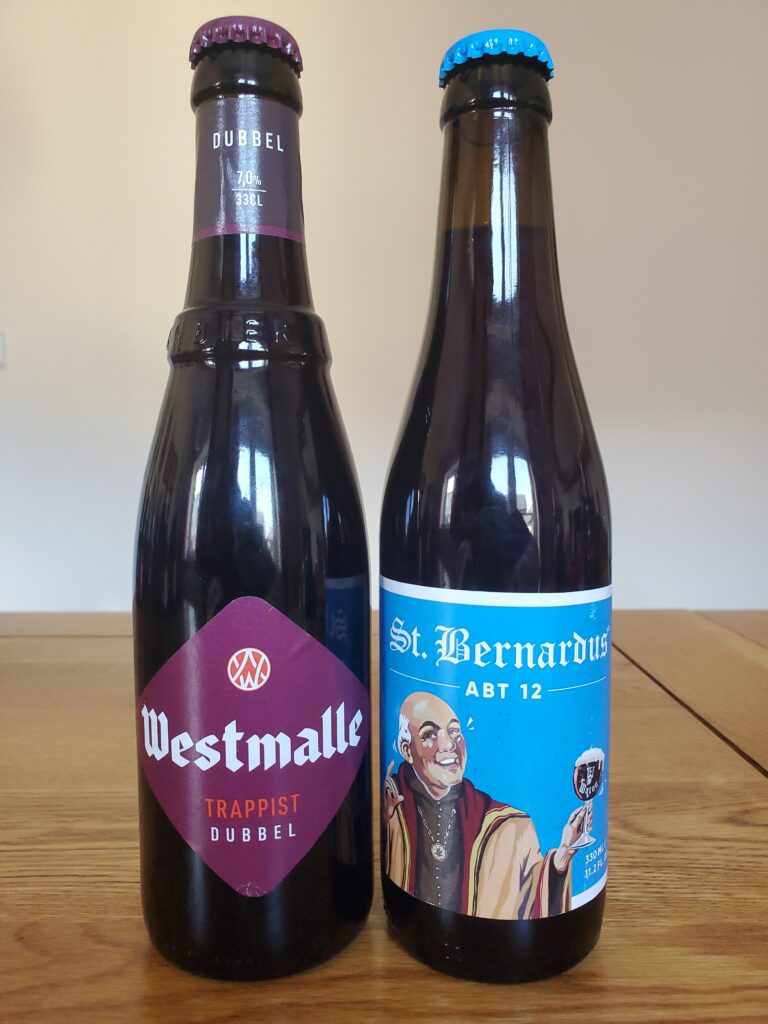
Week 5: Westmalle Trappist Dubbel Vs St. Bernardus Abt 12
This week, we tried two strong, dark beers – a Westmalle Trappist Dubbel (7%) and St. Bernardus Abt 12 (10%). And these were two of the best beers so far.
The Westmalle had a lovely, sweet aroma with notes of chocolate and banana. The St. Bernardus had a beautiful creamy mouthfeel and flavours of dried fruits, like dates and raisins, and dark caramelised sugars.
Despite being relatively strong beers, they didn’t have that strong alcohol taste like some of the blondes. And they went down very easily, leaving you wanting more.
Lisa’s thoughts: For me, these are the best beers so far – both with lovely aroma and flavour. The St. Bernardus just pipped it for me, and if it wasn’t so strong, I’d happily drink it all night.
Alex’s thoughts: Big fan of both these dark, complex, unctuous styles. The higher ABV of St. Bernardus gave it a stand-out mouth feel and is rightly one of the highest scoring beers I’ve ever tried.
Beer of the night: St. Bernardus Abt 12
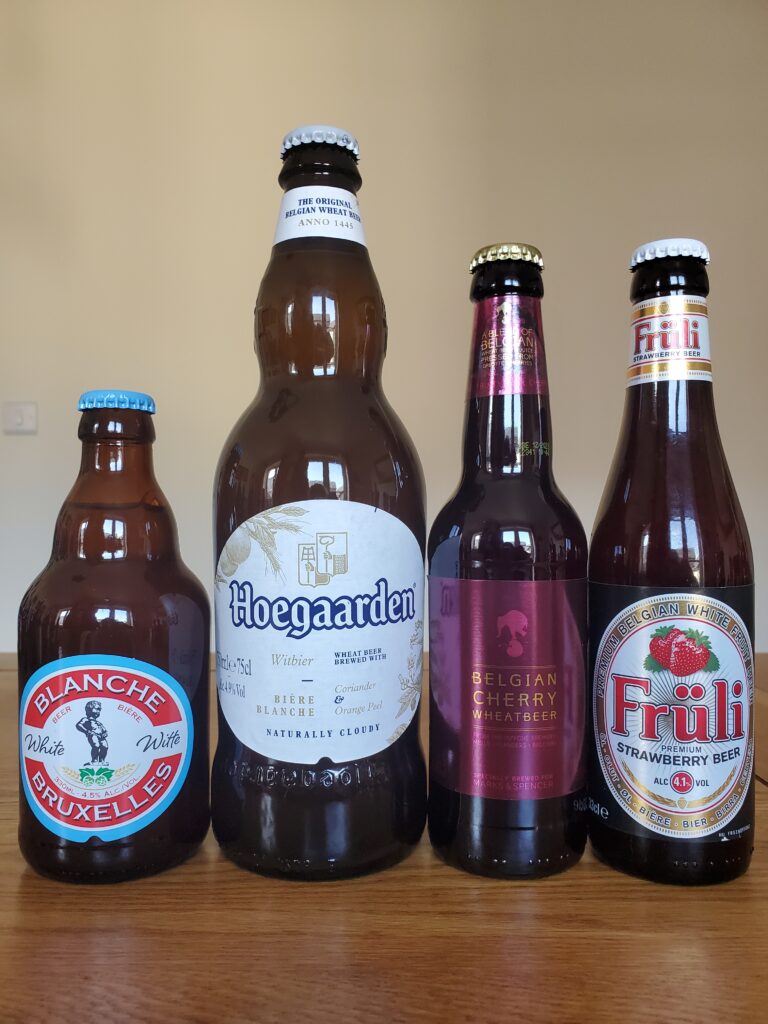
Week 6: Battle of the witbiers
Four Belgian witbiers this week. Two traditional wits – Blanche de Bruxelles (4.5%) and Hoegaarden Blanche (4.9%). And two fruity wits – M&S Cherry by Huyghe (3.5%) and Früli Strawberry (4.1%).
These beers all have a lower ABV than some of the beers in previous weeks and you can tell. All of them were very light, refreshing and easy-drinking.
First up, we tried the two traditional wits – both of which we have tried in the past. The Blanche de Bruxelles was light, with notes of orange in the aroma and taste. Very quaffable, but not much too it. A nice beer for a sunny afternoon in the garden.
The Hoegaarden had a little more complexity with notes of cloves and coriander. Still a light, refreshing beer, but with more body. Not as heavy and filling as some wheat beers, so you could have a couple of bottles.
Next, we moved on to the fruity beers, bringing back the M&S special from week three and introducing the Früli strawberry. As you would expect from fruity beers, these are very sweet, which means you probably wouldn’t want too many as they’d get a bit sickly. Both very nice as a dessert beer or spacer.
The Früli was the sweeter of the two, with a slight tang on the finish. The cherry beer had a good body and a deeper, more decadent flavour with the sweet and sour cherry flavours coming through.
If you aren’t a fan of the stronger beers or very hoppy beers, these make a nice selection.
Lisa’s thoughts: All very nice beers – would happily drink these in the garden on a sunny afternoon. The Blanche de Bruxelles was pleasant, but I didn’t think there was much to it in terms of flavour. The Hoegaarden was very nice, but not as good as some of the German wheat beers I’ve had in the past.
Both the fruity beers were sweet. The Früli reminded me of Kopparberg strawberry and lime cider – very easy to drink with no alcohol flavour. The cherry was more complex. I couldn’t have too many of these – I felt like I could feel the sugar on my teeth after drinking them – but would be good as a spacer between stronger beers.
Alex’s thoughts: The history of the wit style really appeals to me – the notion that beers were flavoured with exotic fruits, herbs and spices that passed through Belgium and the Netherlands during the height of their naval trade empire. There’s nothing else quite like it and without tasting them, it would be easy to assume spices like coriander have no place in beer. The reality is that it works and works really well.
It’s by no means my favourite style and given the choice I would favour the flavour profile offered up by traditional German wheat beers over Belgian wits, but nonetheless they rightfully deserve their place in the great beer wheel of styles.
Beer of the night: M&S Cherry by Huyghe
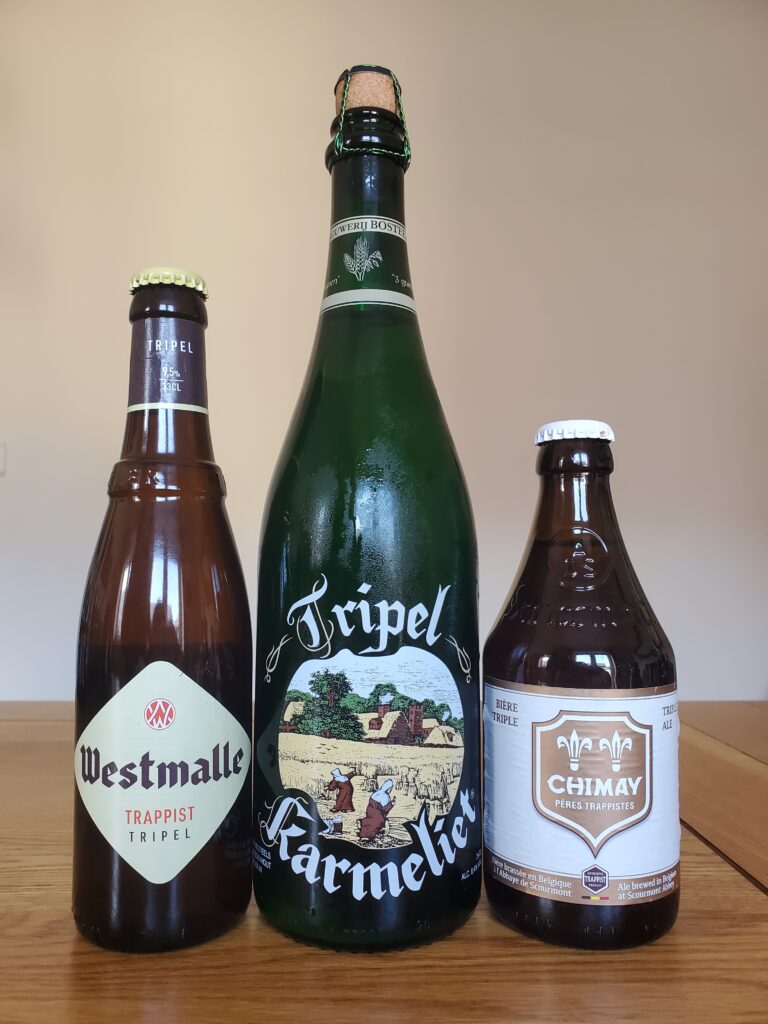
Week 7: Tripels and Trappists
This week’s selection was made up of Tripels and Trappists – Westmalle Trappist Tripel (9.5%) and Tripel Karmeliet (8.4%), and Chimay Trappist (8%).
The Chimay had a gorgeous amber colour, while the other two beers were slightly lighter. It was also the driest of the three with the strongest alcohol flavour.
The Karmeliet was the fizziest, but as it started to lose its fizz, it got better and better. Given the high ABV, it was actually very easy to drink. The Westmalle was the sweetest and most decadent, with a lovely banana flavour coming through from the yeast.
Lisa’s thoughts: I definitely prefer Tripels and Trappists to Blondes, and these three beers were all fantastic. On the first taste, the Westmalle was my favourite, but the more I went back to the Karmeliet, the more I liked it. In the end, the Karmeliet just pipped it. The Chimay was a great beer, but perhaps a little too dry for me.
Alex’s thoughts: I really liked the Chimay, but the herbal bitterness at the backend was just a bit too much to be my favourite. The Westmalle was delicious, but I think the upfront sweetness could get a little bit clawing after a while, whereas the Karmeliet had a perfect balance. The more I went back to the Karmeliet, the more I was reminded of how good it was.
Beer of the night: Karmeliet Tripel

Week 8: Lambics – Oude Gueze
This week we tried our first lambics, opting for two oude guezes – Timmermans at 6.7% and Boon’s Mariage Parfait at 8%.
We were a little apprehensive about these as we really wanted to like them, given that lambic beer is one of the most traditional and oldest styles of beer.
Fortunately, we weren’t disappointed. Both beers were absolutely fantastic. And despite, being the same style, had very different flavours.
The Timmermans was very sour – the sort of sour that makes your mouth pucker – but it had a lovely dry finish. The Mariage Parfait was more subtle on the sourness, with a funkier flavour and the woodiness from the oak barrels coming through.
Both these beers were absolutely delicious, and neither tasted that strongly of alcohol, despite the wine-like aromas. They went down very easily, with each mouthful leaving you wanting more.
Lisa’s thoughts: I thought the Timmermans had a strong aroma with hints of wine coming through along with a fustiness. I wasn’t excited by the aroma, but fortunately, the taste was fantastic. The sourness hit you hard, which is great for me as I love sour flavours.
The Mariage Parfait tasted more in line with how it smelt. It didn’t have the smack you in the face sourness – instead there was an almost woody taste on the back end. At first, I wasn’t sure, but the more I drank, the more I enjoyed it.
Alex’s thoughts: The Timmermans had lots of funk and lots of tart sourness that hit me at the back of my mouth. Even though it has a dry finish, it really leaves you salivating and has that moreish quality that leaves you wanting to dive back in.
The tartness and sourness were more toned down in the Mariage Parfait. I got more of a lemony tartness with a slight fruitiness and more zip on the finish. Not quite as complex, but makes it a little bit more sessionable than the Timmermans (despite the higher ABV).
Beer of the night: Tie
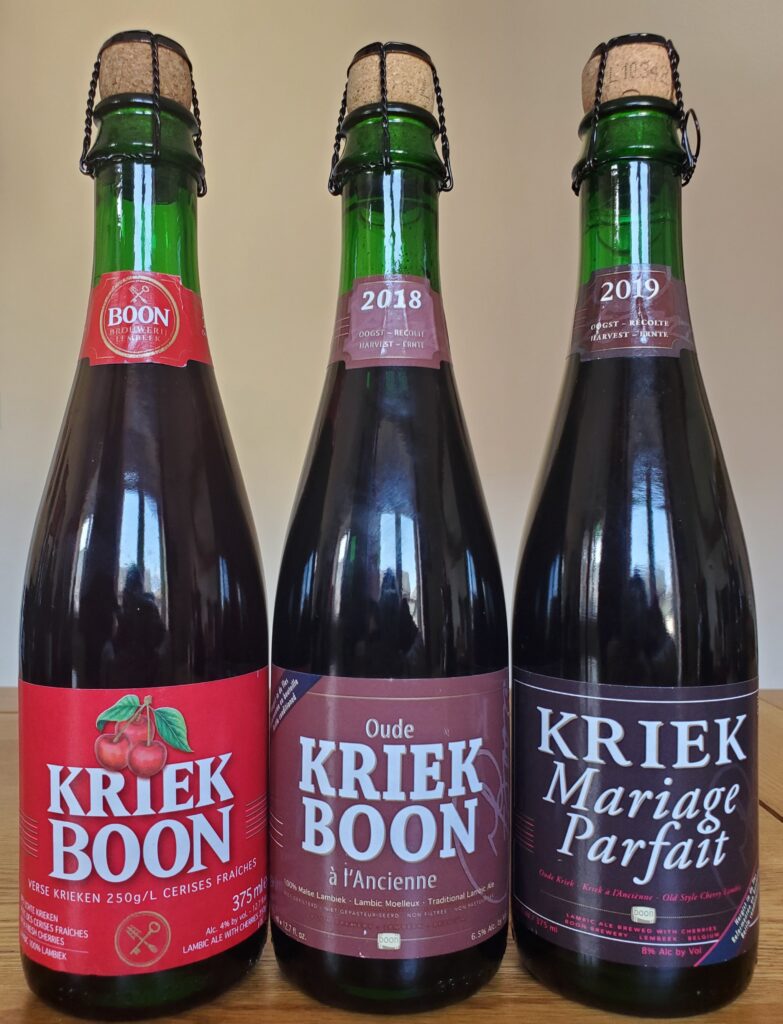
Week 9: Fruity Lambics
This week we stayed with the lambics but opted for three cherry lambics – Kriek Boon (2021) 4%, Oude Kriek Boon à l’Ancienne (2018) 6.5% and Kriek Mariage Parfait (2019) 8%.
First up was the Kriek Boon, which was sweet but not too sweet. It didn’t quite have the puckering sourness of last week’s lambics, which was surprising given it’s made with 25% sour cherries.
Next up was the Oude Kriek Boon. This wasn’t as sweet as the Kriek Boon, and had more of the traditional lambic flavours – the funky sourness – coming through. It had a much drier finish than the Kriek Boon.
Finally, we tried the Kriek Mariage Parfait. This was the driest and had the least sweetness but the most funk and a lovely oakiness. The cherry flavour didn’t come through as much, but it was a beautifully balanced beer.
Lisa’s thoughts: Another three delicious beers, which despite being the same style, were all distinctly different. The Oude Kriek Boon à l’Ancienne was my favourite of the night because it had more of the lovely sourness of the traditional lambics.
Alex’s thoughts: When comparing the three, I found the Kriek Boon the sweetest and the Mariage Parfait driest. I preferred the Oude Kriek Boon as I felt it was more balanced between sweet and sour.
Beer of the night: Oude Kriek Boon à l’Ancienne
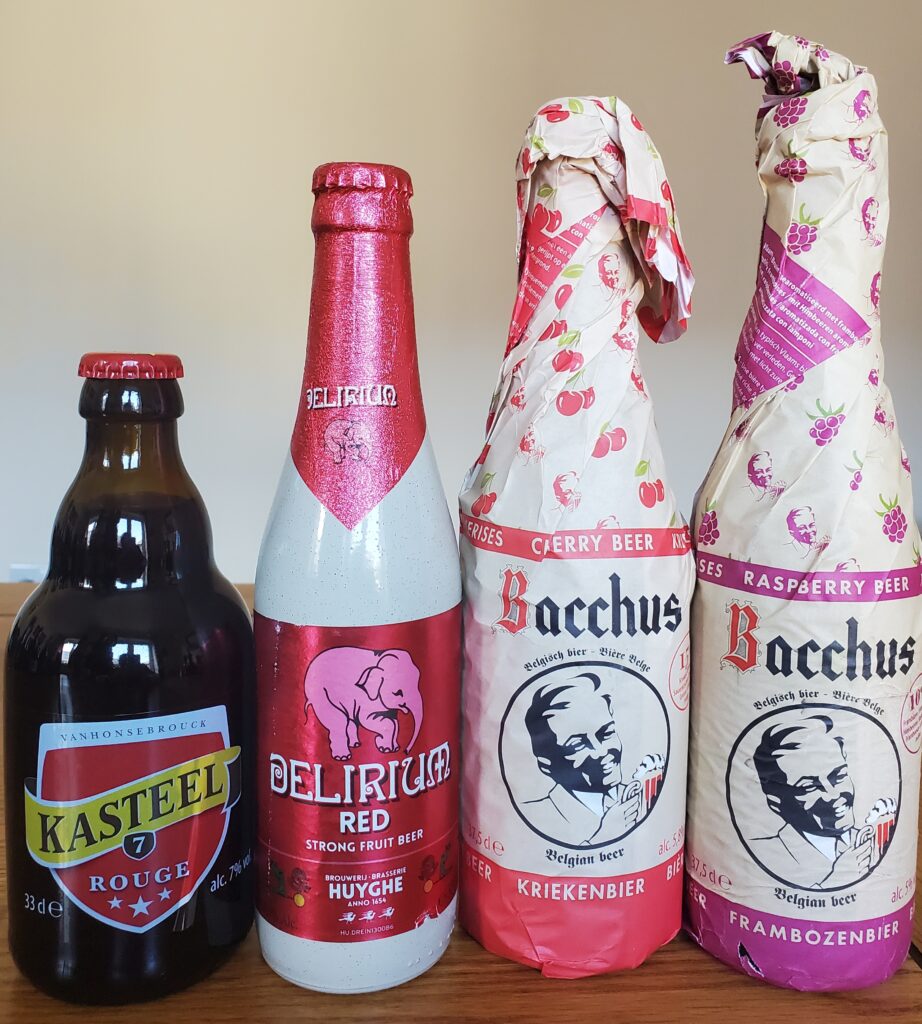
Week 10: Fruity beers
This week opted for four fruity beers. We started with two Bacchus beers – Bacchus Frambozenbier (raspberry) 5% and Bacchus Kriekenbier (cherry) 5.8%. Then we had two more cherry beers – Kasteel Rouge 7% and Delirium Red 8% (which we tried in an earlier week).
Both the Bacchus beers smelt and tasted like their respective fruits. The raspberry was super smooth, fruity and sweet with a little bit of sourness on the back end. Very easy to drink and the sweetest beer of the night.
The Bacchus cherry was the least sweet of the selection, with the sourness of the cherries coming through without being overpowering. The old Flemish brown base of the Bacchus beers was delicious, coming through more on the cherry.
The Kasteel was the most carbonated so fizzed around the mouth more, giving a longer finish and making it the most refreshing. The Delirium had a thicker body and a lovely depth of flavour with a lovely cherry base.
The Kasteel would make a lovely aperitif, while the Delirium is more of a dessert beer in place of sherry or port.
Lisa’s thoughts: I found this week’s selection the hardest to score as they were all very good beers, with none of them being head and shoulders above the rest or inferior to the rest.
In the end, I scored the raspberry lowest. It was a delicious fruity beer, but it didn’t have the complexity of flavour of some beers, and the sweetness would probably get too much if you drank too many.
While I still enjoyed the Delirium, I enjoyed the Bacchus cherry and the Kasteel slightly more. The Kasteel was the most refreshing, which probably came through more because it was a hot day. The Bacchus had just a little bit more sourness and I love a sour beer.
Alex’s thoughts: Comparing the two Bacchus beers, I prefer the cherry. The raspberry was very nice, but had a bit too much sweetness upfront, and the flavour dissipated quickly, whereas the cherry had more balance between sweet and sour. The bold character of the old Flemish brown ale base shone through a bit more on the cherry because it wasn’t masked by the sweetness like it was with the raspberry.
Kasteel is more carbonated, and it’s a little bit thinner, so I think you get a bit more of that sweetness upfront compared to the Bacchus cherry. But it’s ultra refreshing and lighter, so it is great for an aperitif. Delirium has a thicker body, and it’s got more depth to it and is a perfect after-dinner drink.
Beer of the night: Bacchus Kriekenbier
Week 11: Miscellaneous
This week’s beers don’t necessarily fit into a specific category, so we labelled them as miscellaneous.
First up, Saison Dupont 6.5% – brewed since 1844 and considered a classic Belgian seasonal ale. A refreshing beer, with notes of orange zest and cloves. It was well-carbonated with a lingering flavour. It had the pepperiness of Duvel, but it was more balanced, so it wasn’t unpleasant.
Next up was Duchesse De Bourgogne 6.2% – a Flemish red ale, brewed in oak casks. This beer was one of the most interesting beers we’ve ever tried. It was sweet and sour with a beautiful oaky flavour. It had notes of sour cherries (despite not having any fruit in it) and the kind of sweetness you get from Balsamic vinegar. It was fizzy on the tongue, but smooth at the same time. It felt like you got something different on every taste bud.
Finally, we tried the Orval 6.2% – a unique beer that is so good it’s the only one the brewery makes. Our Orval had been in bottle for 11 months – some people say it gets better with age. It had a lovely frothy head, a well-balanced flavour that was funky and bretty, and a hoppy, bitter finish.
Lisa’s thoughts: This week’s beers were excellent – a great way to finish off our Belgian beer battle. Saison isn’t my favourite style of beer, but the Saison Dupont was very good. Although it had that pepperiness that the Duvel had, I didn’t find it unpleasant and would happily drink a couple of bottles in one session.
The Orval was good, but it didn’t wow me in the way I had hoped. It’s pegged as one of the top Belgian beers, so I had high hopes. It did get better as it warmed up and I would definitely try it again – maybe opting for one that has been in the bottle for longer.
For me, the standout beer was the Duchesse De Bourgogne. It’s not my favourite beer ever, but it’s definitely one of the most interesting, exciting, and complex beers I’ve ever tasted. There were so many different flavours, and every mouthful gave you something new, making it difficult to describe. One of my favourite beers of the whole Belgian selection.
Alex’s thoughts: I thought the Saison Dupont had notes of peach or apricot yoghurt. It was a refreshing beer with a nice balance of flavour and spiciness.
The Duchesse De Bourgogne had a sherry or port-like aroma, probably from the oak barrels. In the mouth, it was both sweet and sour at the same time – an intense complex flavour that even got you under your tongue. A delicious beer.
The Orval had so many of those Belgian flavours – the spiciness from the yeast and a lovely bitterness. I’d like a little more sweetness, which you might get from an older bottle.
Beer of the night: Duchesse De Bourgogne

